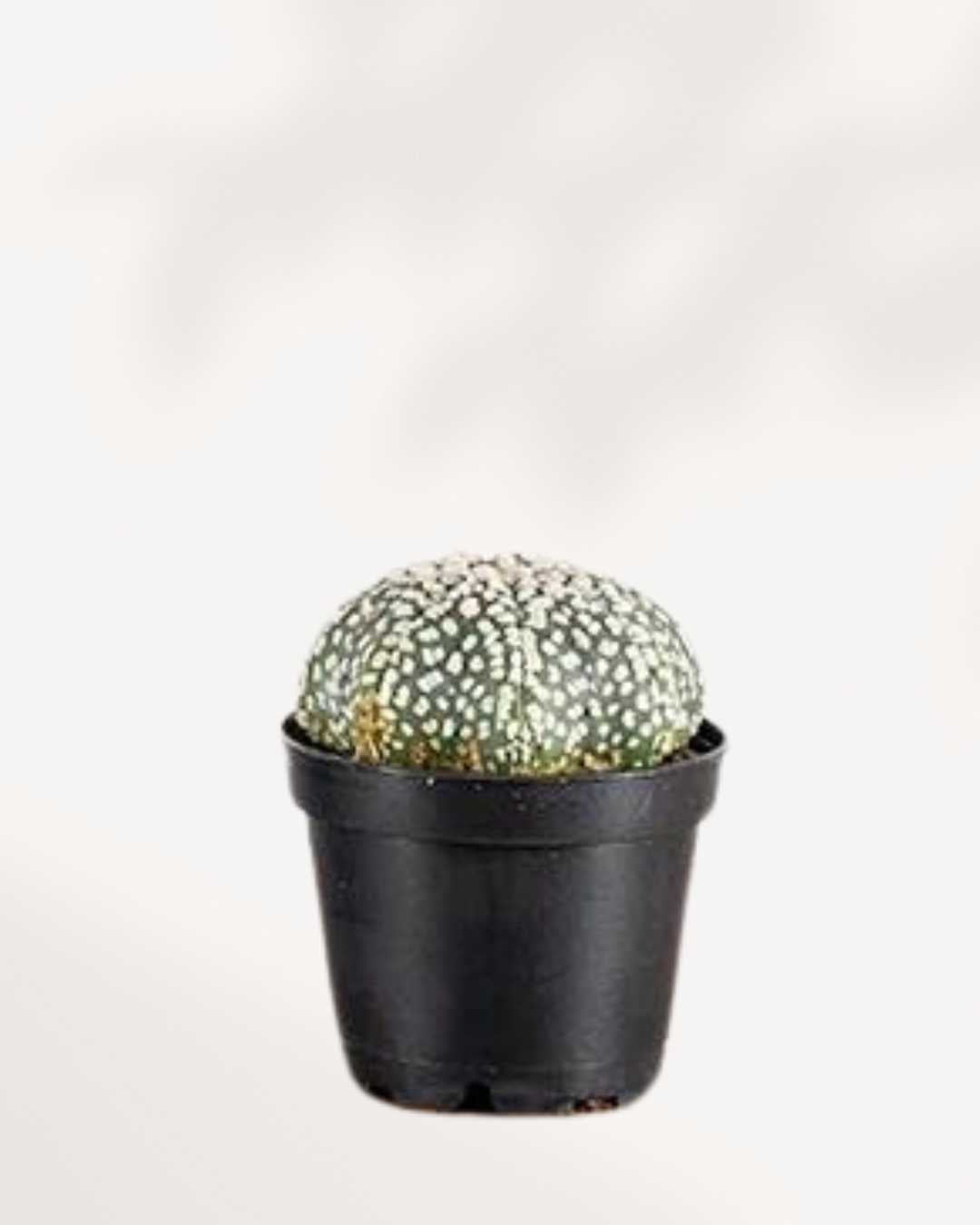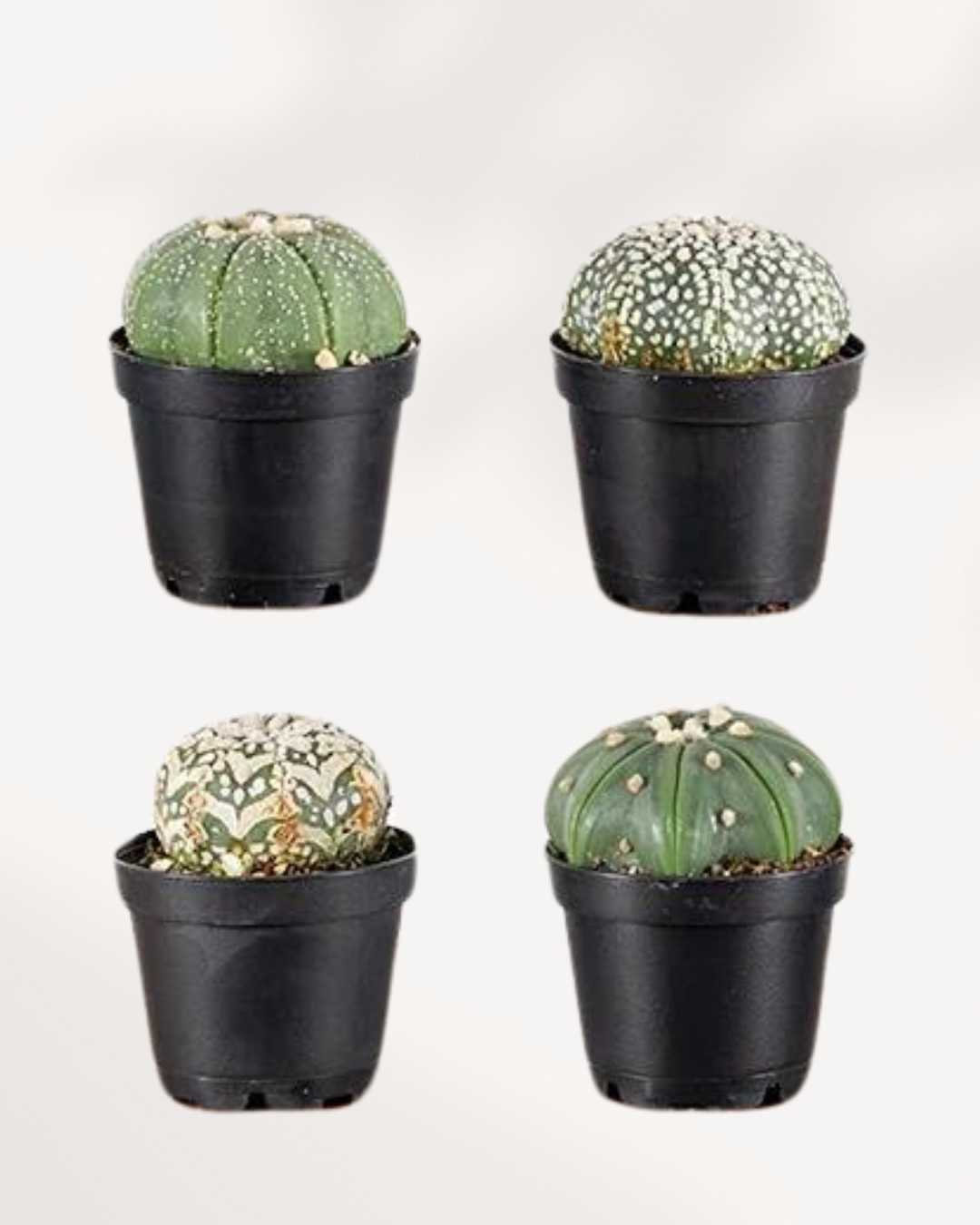Couldn't load pickup availability
Astrophytum Asterias, also known as the Star Cactus, is a unique and eye-catching succulent prized for its symmetrical shape and ornamental patterns. Its spineless, round body makes it a favorite among collectors and succulent enthusiasts. Native to Mexico and Texas, this low-maintenance cactus thrives in bright, sunny spaces, adding a touch of desert elegance to any setting.
Common Names
- Astrophytum Asterias
- Star Cactus
- Sand Dollar Cactus
Botanical Classification
- Kingdom: Plantae
- Order: Caryophyllales
- Family: Cactaceae
- Genus: Astrophytum
- Species: Astrophytum asterias
Native Habitat
Astrophytum Asterias is native to arid regions of Mexico and southern Texas, where it grows in sandy and well-drained soils. Its natural habitat allows it to thrive in dry, sunny environments with minimal water.
Historical and Cultural Significance
The Astrophytum Asterias is highly valued in succulent collections due to its star-like appearance and ornamental qualities. It has become a symbol of resilience and adaptability, making it a popular gift and display piece.
Uses and Popularity
Astrophytum Asterias is primarily grown as an ornamental plant. Its compact size and striking patterns make it perfect for windowsills, desktops, and small containers. It’s also commonly featured in cactus gardens and terrariums.
Conservation Status
Astrophytum Asterias is considered vulnerable in the wild due to habitat loss but is widely propagated and available through nurseries and online stores.
Description
Physical Characteristics
Astrophytum Asterias features a round, flat body segmented into symmetrical sections resembling a star. Its surface is covered in tiny white dots, giving it a speckled appearance. It produces bright yellow flowers with orange centers, adding seasonal color.
Growth Habit
This slow-growing cactus typically reaches 2-3 inches in height and 4-6 inches in diameter. Its compact growth makes it ideal for small containers and decorative arrangements.
Popular Plant Varieties
Succulent Surprise Box
- A curated selection of unique and popular succulents perfect for beginners and collectors.
Jade Ovata Shrek
- Known for its tubular leaves that resemble "Shrek" ears, adding character to succulent arrangements.
String of Pearls
- Trailing stems with bead-like leaves, ideal for hanging baskets.
Living Stone Lithops
- Unique stone-like appearance, perfect for sunny windowsills and dry conditions.
String of Hearts - Pretty Pink
- Delicate, trailing vines with heart-shaped leaves and pink accents.
Care Guide
Light Requirements
Astrophytum Asterias thrives in bright, direct sunlight but can tolerate partial shade. Place it near a sunny window or under grow lights for optimal growth. Learn More
Watering Needs
Water sparingly, allowing the soil to dry completely between waterings. Overwatering can lead to root rot, so ensure proper drainage. Indoor Plant Watering
Soil Preferences
Use a well-draining cactus mix with added sand or perlite for aeration. Indoor Potting Mix
Temperature and Humidity
Prefers warm temperatures between 65°F and 85°F (18°C–29°C) and low humidity. Protect from frost during colder months.
Common Pests
Mealybugs
Mealybugs appear as white, cotton-like clusters on the plant. Treat with rubbing alcohol or insecticidal soap. Learn More
Spider Mites
Spider mites cause webbing and discoloration. Maintain humidity and treat with neem oil or insecticidal spray. Learn More
FAQs
How often should I water Astrophytum Asterias?
Water sparingly, only when the soil is completely dry. Reduce watering in winter.
Is Astrophytum Asterias pet-friendly?
No, it is not pet-friendly and should be kept out of reach of pets.
Can it grow indoors?
Yes, it thrives indoors with bright sunlight and proper drainage.
Does it flower?
Yes, it produces bright yellow flowers with orange centers during its growing season.
How to take care of Astrophytum Asterias
Sun: Direct & Indirect
Sun: Direct & Indirect
Light: Medium - Bright
Light: Medium - Bright
Water: When fully dry
Water: When fully dry
Humidity: Low
Humidity: Low
Pet Friendly: Caution
Pet Friendly: Caution
Pro Tip
Pro Tip
Delivery Policy for Plant Condition
Delivery Policy for Plant Condition
"I have only received part of my order. What to do?
No worries if you've only got part of your order! Our plants come from different nurseries and might arrive in separate shipments, typically 1-2 days apart. It's all part of ensuring your green friends reach you in top-notch condition!
If you do not receive the remaining packages within 48 hours contact support at info@mygreenscape.ca
What is the Life Time Support?
Absolutely! Lifetime support means you can count on us whenever you have questions or uncertainties about your plant. Whether you're puzzled by its behavior or just want to ensure it's thriving, we're here for you. Connect with us on Instagram @mygreenscapeto or shoot us an email at support@mygreenscape.ca.
When it comes to our guarantee for plants shipped with standard or express, rest assured that we offer a 30-day happy healthy plant guarantee on all such shipments. This ensures that your plants are covered for 30 days after delivery, giving you peace of mind regarding their condition. If you have any concerns within this period, feel free to reach out to us for assistance.
For further details, please visit our Local Delivery, Store Pickup, Standard Shipping Guide Page.
What to expect
What to expect
Your plant will arrive in a standard nursery pot, typically 0.5" - 1" smaller than the stated size to seamlessly fit into your chosen decorative pot. Washable Paper Planter Bags are available for separate purchase.
Just like nature intended, each plant is unique, showcasing natural variations in size, shape, and characteristics. Our commitment is to deliver a plant that closely resembles the one featured on our website, matching your chosen size, and with the potential to thrive happily in your home.
Frequently Asked Questions
Frequently Asked Questions
Certainly! If you're pondering about ordering plants online, you're not alone. We've compiled the most frequently asked questions. Check out our FAQ section here for quick answers! Happy planting!
Plant & Pot Size Chart
Plant & Pot Size Chart
Choosing the right pot size for your plants can be a daunting task, especially if you're new to gardening. But fear not! Our pot sizes chart can help you find the perfect match for your plants, ensuring they have enough space to grow and thrive. With our guide, you'll be able to confidently choose the right pot size and plant variety for your gardening needs.
Plant Pot Size Guide.

| Extra Small | 7-10 cm | 2.5 - 3 inches |
| Small | 11-12 cm | 3.5 - 4 inches |
| Medium | 14-17 cm | 5 - 6 inches |
| Large | 19-21 cm | 8 - 10 inches |
| Extra Large | 24-27 cm | 12 - 14 inches |
All sizes are specified in product details.
Your Complete Guide to Pot Sizes: What Size Should You Choose?

When selecting a pot for your plant, it's important to find the right size. But with all the different options out there, how do you know which one is best? We're here to help!
MyGreenscape's pot sizes chart is a great resource for finding your perfect fit. Our easy-to-read chart takes out all the guesswork and helps you quickly choose the right size for your plant.
Smaller pots are best for seedlings or small plants just starting out. These tend to be shallow but wide, allowing enough room for the roots of the young plant but not too much where they get overcrowded. Medium-sized pots are ideal when your plant has grown from its infancy and is ready for more space. These are deeper and wider than small pots, so that it can accommodate larger root systems - making sure your plant gets enough nourishment while still giving it breathing room. Large pots are top choice if you have an established plant in need of lots of space - think trees and large shrubs! The spacious depth and width allow plenty of room for deep root systems without struggling for air or light.
No matter what size you choose, MyGreenscape has got you covered, with our pot sizes chart guaranteeing you find the perfect fit every time!
Winter Shipping Protection
Winter Shipping Protection
We take extra care with each package during the colder months. For destinations experiencing cold weather, we provide insulated packaging and heat packs as needed to protect your plants from freezing temperatures. With Winter Shipping Protection, your plants are equipped to arrive safe and sound, even in winter’s chill.
Care Guide
Care Guide
Explore essential care tips. check out our Comprehensive Resource for Indoor Plant Care.


WATERING MADE EASY
Check soil moisture before watering and use a potting mix that drains well. It’s the secret to healthy, happy plants!
Hear From Happy Plant Parents.
Who have brought Mygreenscape plants into their homes.














